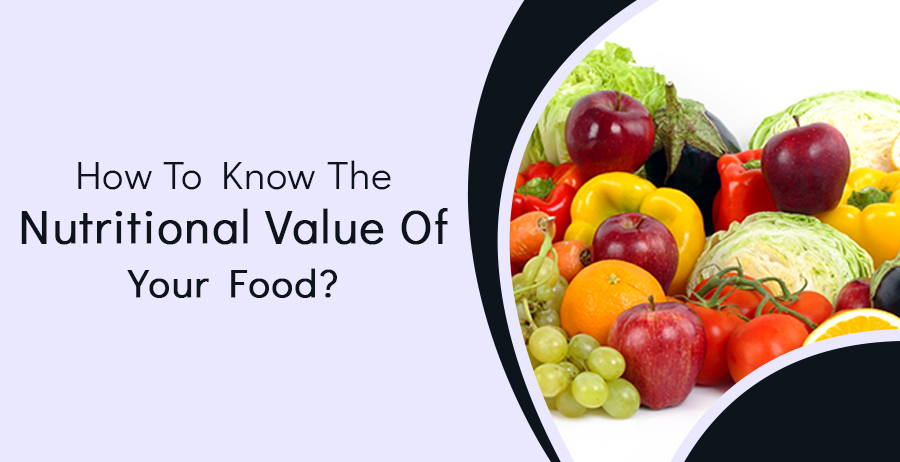Table of Contents
How To Know The Nutritional Value Of Your Food?
Overview:
Nutritional values are not only required by law in most countries worldwide, but they also assist customers in deciding which products to purchase.
Consumers can make more informed decisions regarding their food choices with this information. What is the process for determining the nutrient value of food?
In this post, we will explain how to know the nutritional value of your food.
What is Nutritional value?
The sum of the nutritional values of the nutrients contained in a food product determines its nutritional value.
Energy (kilojoules or calories), fat, protein, saturated fat, sugar, carbohydrates, and sodium (a component of salt).
These are among the most commonly consumed nutrients. There is a general requirement for data of 100 g and data of serving size per 100 g.
-
Energy
First of all, nutritional value is a measure of how much energy a product contains. These ingredients provide the human body with a certain amount of energy.
Each of us requires energy daily to function properly.
-
The Macronutrients
Secondly, the nutritional value of a food indicates the types of molecules present in it and how many of those molecules are present.
A molecule is divided into functional groups based on its function. Molecules that are most often found in nature are:
- Carbohydrates
- Fats
- Proteins
There are macromolecules involved in this process. It is safe to say that nearly all foods and drinks contain at least one of these ingredients (except pure water, for example).
It is essential for the survival of humans that they exist. In addition to providing energy to the body. These ingredients are also the primary energy source.
A carbohydrate or fat can be broken down into smaller molecular groups. An example would be splitting carbohydrates into sugars and fats into saturated and unsaturated fats.
Understanding that good food is more than just proteins, carbohydrates, and fat is important. A certain amount of vitamins and minerals is also required.
On food labels, you will also find this information. To obtain medication like Cenforce 100 or Vidalista 60, you should consider a Genericmedsstore.
Nutrition Labels: What’s on them?
Government regulations require nutrition facts labels to provide a wealth of information that will assist you in making informed decisions when purchasing food.
They must first identify the number of servings in the package, can, or bottle. Also, they’ve got to tell you how many calories are in it (total calories and fat calories).
Also how much fat, how much-saturated fat, how much cholesterol, how much sodium, how much carbohydrates, how much dietary fat, how much sugar, and how much protein per serving.
The nutritional value of the ingredients you use in your favorite healthy recipes is important to know. If you do a lot of cooking these days.
It is important to note that the nutrition information is included on the labels of the packaged ingredients.
It is important to note that fresh vegetables and fruits, some bakery goods, and items from the dairy and meat departments will not have labels.
You will need to conduct some research in this regard.
3 methods for determining nutrient content
When determining the nutritional value of food. We must first determine how much of each component is present.
Do you know how much protein, carbohydrates, fats, vitamins, etc., your food contains?
1. Analyze the contents in a laboratory
Foods can be analyzed using various analytical methods to determine their nutritional value. The types and amounts of sugar, fat, etc., can be determined using various methods.
To obtain a comprehensive nutritional profile of a product, laboratories will specify which methods are required. Chemical analysis techniques are used for all of the required analyses.
A very small sample is typically used in these techniques to decide. As products can be variable, ensuring that the sample size represents the product under test is crucial.
It may also be necessary to consider the protein’s quality, depending on where you live. Some proteins are considered to be more ‘complete’ than others.
Depending on the country, you may need to adjust the overall protein content using a separate factor (e.g. PDCAAS).
2. Literature-based values were used
The nutritional content of various products has been investigated over time. These existing values apply to your product. You might be able to use them when determining the nutritional value.
Many countries generally accept the nutritional values of food products in their databases. The FDA approves and maintains a very extensive and publicly accessible database in the United States.
Many other countries, including the Netherlands, have similar programs.
3. Determine your nutritional value
It is unlikely that you will be able to find literature values for your product if it is made according to your recipe with a unique composition.
However, you may discover the nutritional value of the ingredients you used. The nutritional value of your product can be calculated using those values if they exist.
You must know how much of your recipe consists of each ingredient. Using percentages makes this easier to understand. Once you have calculated these percentages, you can determine how much of each nutrient your product contains.
Using the following example:
- Your product has 25% of ingredients A and 75% of ingredients B.
- The fat content of ingredient A is 10%, and the carbohydrate content is 50%.
- The protein content of ingredient B is 7%.
- As a whole, the composition will look like this:
- As a percentage, fat is 5% since 10/100 x 25 + 0 = 2.5%.
- Amount of carbohydrates: 50/100 x 25 = 12.5%.
- Amount of Protein: 7/100 * 75 = 5.25%.
It is possible to perform these calculations simply and reliably if you mix ingredients.
If your product undergoes a great deal of chemical reaction or significant amounts of water evaporate, this method is no longer effective.
It is possible that some molecules have reacted and evolved into something different, for example.
✍Final Words
You should decide if you can find relevant data in existing literature before trying to determine your product’s nutritional value.
When that’s the case, you can use them to calculate the nutritional value of your food, sometimes with some additional calculations. At Genericmedsstore, you can get affordable medication.





